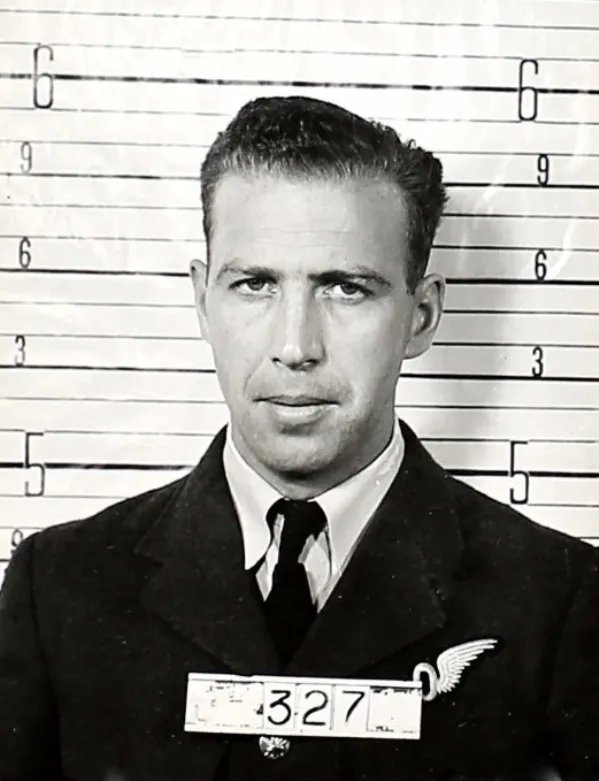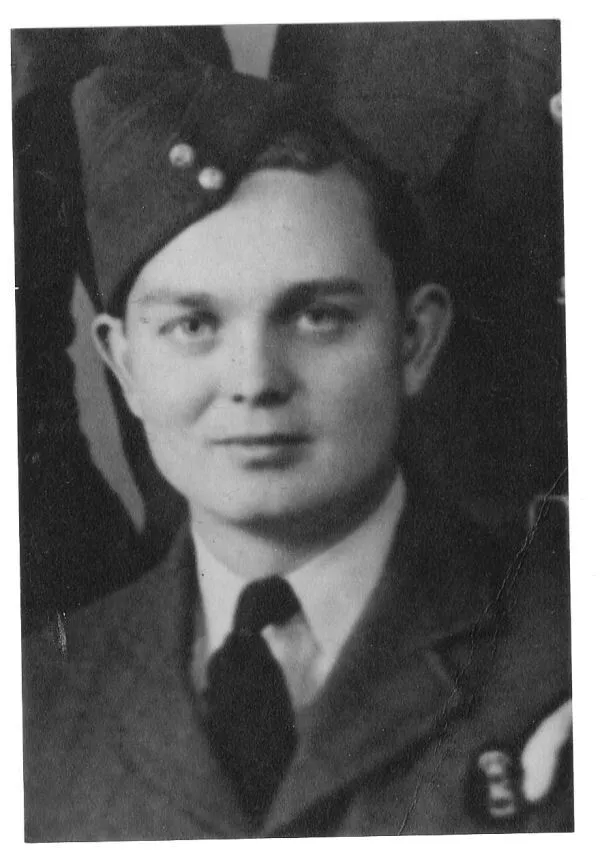Hughes, Raymond (Flight Sergeant)
Killed in Action 1943-December-16


Birth Date: 1924-July-20
Born: Bangor, Gwynedd, Wales
Parents: Son of David and Annie M Hughes, of Bangor, Caernarvonshire
Spouse:
Home: Bangor, Caernarvonshire, Wales
Enlistment:
Enlistment Date: unkown date
Service
RAFVR
Unit
432 (B) Sqn- Squadron
Saeviter Ad Lucem Ferociously toward the light
Base
RAF East Moor
Rank
Flight Sergeant
Position
Flight Engineer
Service Numbers
1808927
Target
Crew or Other Personnel
Lancaster DS831
Mission
Lancaster Mk.II DS831
Bombing Berlin Germany 1943-December-16 to 1943-December-16
432 (B) Sqn (RCAF) East Moor
Battle of Berlin
483 Lancasters and I0 Mosquitoes on the main raid and 5 further Mosquitoes dropped decoy fighter flares south of Berlin.
The bomber route again led directly to Berlin across Holland and Northern Germany and there wore no major diversions, The German controllers plotted the the course of the bombers with great accuracy; many German fighters were met T the coast of Holland and further fighters were guided on to the bomber stream throughout the approach to the target. More fighters were waiting at the target and there were many combats. The bombers shook off the opposition on the return flight by taking a northerly route over Denmark. 25 Lancasters, 5.2 per cent of the Lancaster force, were lost. Many further aircraft were lost on returning to England (see later paragraph).
Berlin was cloud-covered but the Pathfinder sky-marking was reasonably accurate and much of the bombing fell in the city. The local report says that the raid hit no identifiable aiming point but the central and eastern districts were hit more than other areas. Little industrial damage was caused; most of the bombing hit housing and railways. Conflicting figures on the number of dead are given; the overall tot may be 720, of which 279 were foreign workers - 186 women, 65 men and 28 youths 70 of these foreigners - all from the East - were killed when the train in which they were travelling was bombed at the Halensee Station. In the city centre, the National Theatre and the building housing Germany's military and political archives were both destroyed. The damage to the Berlin railway system and to rolling stock, and the large numbers of people still leaving the city, were having a cumulative effect upon the transportation of supplies to the Russian Front; 1000 wagon-loads of war material were held up for 6 days. The sustained bombing had now made more than a quarter of Berlin's total living accommodation unusable.
On their return to England, many of the bombers encountered very low cloud at their bases. The squadrons of 1, 6 and 8 Groups were particularly badly affected. Lancasters (and a Stirling from the minelaying operation) either crashed or were abandoned when their crews parachuted. The group with heaviest losses was 1 Group with 13 aircraft lost; the squadron with heaviest losses was 97 Squadron, 8 Group with 7 aircraft lost. There is a little confusion in Bomber Command records over aircrew casualties but it is probable that 148 men were killed in the crashes, 39 were injured and 6 presumed lost in the sea.
source: The Bomber Command War Diaries, Martin Middlebrook and Chris Everitt
Lancaster BII aircraft DS 831 QO-N was shot down by night fighter pilot Oblt Heinz-Wolfgang Schnaufer of 12/NJG1 over Holland during operation against targets in Berlin, Germany. The Lancaster crashed at Weidum - Wijtgaard, Friesland, Netherlands
Warrant Officer Class 2 HA Turner (RCAF), Warrant Officer Class 1 JS Briegel (RCAF), Sergeant R Hughes (RAFVR), FS TW Pragnell (RAFVR),Warrant Officer RK Saunders (RAAF) and Flying Officer WC Fisher (USAAF) were all killed in action
FS Lewis was either an Evader or was taken Prisoner of War and one of the crew, not Canadian, missing believed killed. Sergeant OD Lewis (RCAF) and FS MAT Brudell (RAAF) survived and were taken as Prisoners Of War
Detail provided by F McAfee, Regina, Saskatchewan
There were two 432 Squadron Lancaster II aircraft lost on this operation. Please see Hatfield, HB for information on Lancaster DS 832 QO-K
![]() 432 Squadron Lancaster DS831 QO-N F/O. Fisher, RAF East Moor,...
432 Squadron Lancaster DS831 QO-N F/O. Fisher, RAF East Moor,...
Lancaster serial: DS831

Canadian Warplane Heritage Museum
The Avro Lancaster is a British Second World War heavy bomber. It was designed and manufactured by Avro as a contemporary of the Handley Page Halifax, both bombers having been developed to the same specification, as well as the Short Stirling, all three aircraft being four-engined heavy bombers adopted by the Royal Air Force (RAF) during the same wartime era.
The Lancaster has its origins in the twin-engine Avro Manchester which had been developed during the late 1930s in response to the Air Ministry Specification P.13/36 for a capable medium bomber for "world-wide use". Originally developed as an evolution of the Manchester (which had proved troublesome in service and was retired in 1942), the Lancaster was designed by Roy Chadwick and powered by four Rolls-Royce Merlins and in one version, Bristol Hercules engines. It first saw service with RAF Bomber Command in 1942 and as the strategic bombing offensive over Europe gathered momentum, it was the main aircraft for the night-time bombing campaigns that followed. As increasing numbers of the type were produced, it became the principal heavy bomber used by the RAF, the Royal Canadian Air Force (RCAF) and squadrons from other Commonwealth and European countries serving within the RAF, overshadowing the Halifax and Stirling. Wikipedia
Unit Desciption
432 (B) Sqn Saeviter Ad Lucem ("Leaside")
History of the Squadron during World War II (Aircraft: Wellington X, Lancaster II, Halifax III, VII)
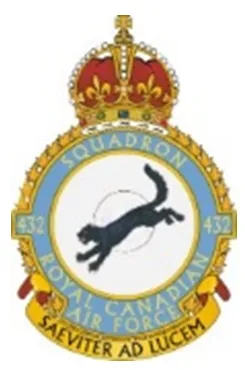
The Squadron was the twelfth RCAF bomber squadron to be formed overseas in WWII. It was formed on May 1, 1943 at Skipton-on-Swale, Yorkshire, UK ![]() as a unit of No 6 (RCAF) Group of RAF Bomber Command: indeed, it was the first bomber squadron to be formed directly into No 6 Group. Using the squadron identification letters QO it flew Vickers Wellington Mk X medium bombers until it moved to East Moor, Yorkshire
as a unit of No 6 (RCAF) Group of RAF Bomber Command: indeed, it was the first bomber squadron to be formed directly into No 6 Group. Using the squadron identification letters QO it flew Vickers Wellington Mk X medium bombers until it moved to East Moor, Yorkshire ![]() on 19th September 1943, when it re-equipped with Avro Lancaster Mk II aircraft. East Moor was part of No 62 (RCAF) Base. The squadron re-equipped with Handley Page Halifax Mk III aircraft in February 1944, and with Halifax Mk VII in July of that year, and continued with them until the squadron was disbanded at East Moor on May 15, 1945.
on 19th September 1943, when it re-equipped with Avro Lancaster Mk II aircraft. East Moor was part of No 62 (RCAF) Base. The squadron re-equipped with Handley Page Halifax Mk III aircraft in February 1944, and with Halifax Mk VII in July of that year, and continued with them until the squadron was disbanded at East Moor on May 15, 1945.
In the course of operations the squadron flew 246 missions, involving 3130 individual sorties, for the loss of 73 aircraft. 8980 tons of bombs were dropped. Awards to squadron members included 2 DSOs, 119 DFCs,1 Bar to DFC, 1 CGM, 20 DFMs and 1 Croix de Guerre (France). Battle Honours were: English Channel and North Sea 1943, Fortress Europe 1943-44, France and Germany 1944-45, Biscay Ports 1944, Ruhr 1943-45, Berlin 1943-44, German Ports 1943-45, Normandy 1944, Rhine, Biscay 1943.Moyes, Kostenuk and Griffin
Squadron History (Bomber Command Museum PDF)
Maps for Movements of 432 Squadron 1943-45
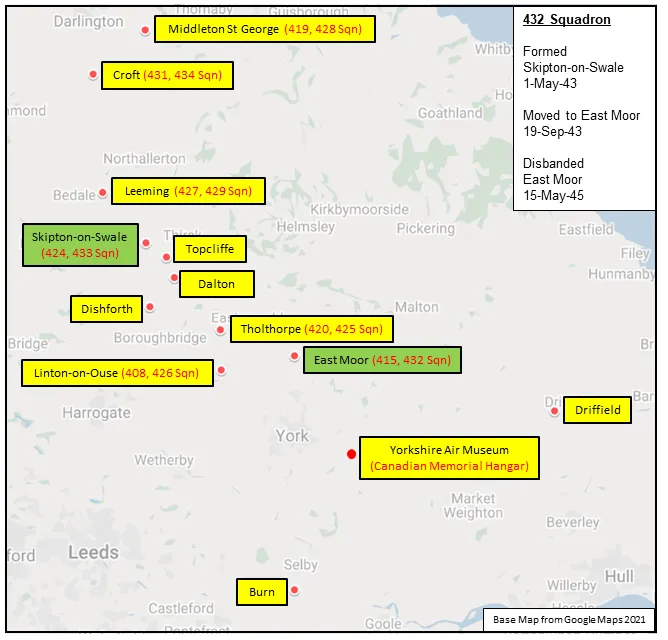
432 Squadron History Summary 1943-45
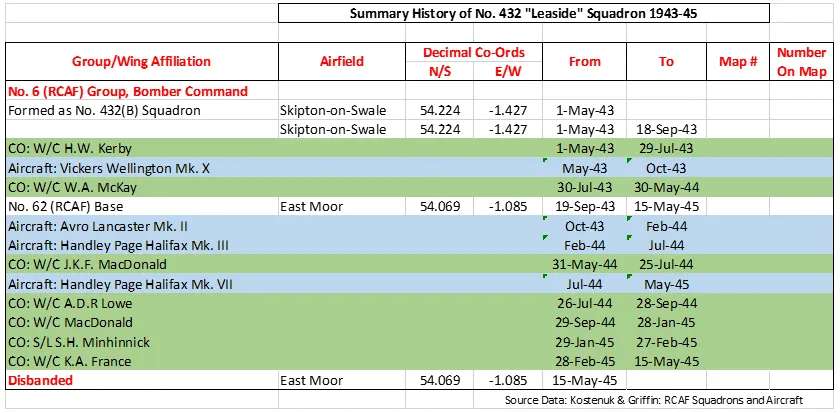
History of the Squadron Post-WWII (Aircraft: Canuck)
The squadron was re-formed at Bagotville, Quebec ![]() as an All-Weather Fighter unit on 1 October 1954. The squadron flew Avro CF-100 Canuck aircraft on North American Air Defence until it was disbanded on 15 October 1961.
as an All-Weather Fighter unit on 1 October 1954. The squadron flew Avro CF-100 Canuck aircraft on North American Air Defence until it was disbanded on 15 October 1961.
